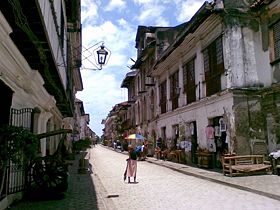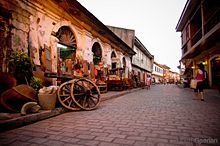Difference between revisions of "Vigan" - New World Encyclopedia
Dan Davies (talk | contribs) |
Dan Davies (talk | contribs) |
||
| Line 22: | Line 22: | ||
==History== | ==History== | ||
| − | Vigan had been detached from the mainland of [[Ilocos Sur province|Ilocos Sur]] by the Abra River, Mestizo River, and the Govantes River. | + | Vigan had been a key coastal trading post in Asia since the fourteenth century C.E. China traded with Vigan, using the Mestizo River that provided a wide access to the delta. Vigan had been detached from the mainland of [[Ilocos Sur province|Ilocos Sur]] by the Abra River, Mestizo River, and the Govantes River. During that era, Vigan had been a peninsula, providing ready access to Chinese ships. Chinese traders brought goods from China, the South Sea Islands and throughout Asia, exchanging them for the products of [[Ilocos Sur province|Ilocos Sur]], especially gold, beeswax, and produce from the surrounding mountains. |
| + | From the sixteenth century, Spanish traders discovered Vigan, quickly seeing the strategic value of the town as a trading port in Asia. Governor General [[Guido de Lavezaris]] wrote King [[Philip II of Spain]] of his desire to settle Vigan.<ref>Blair and Robertson, The Philippine Island, Vol. III, p. 276, </ref> He reported sending Captain Juan de Salcedo with a small company of seventy to eighty soldiers to Vigan. Salcedo departed Manila, arriving in the port city, on June 12, 1572. <ref>[http://www.vigancity.gov.ph/index.php?Itemid=34&id=31&option=com_content&task=view Heritage City of Vigan: History of Vigan] | ||
| − | |||
| − | |||
| − | + | Rather than establishing the port as a fortress city, the Spaniards concentrated on creating a vibrant center for trade. That accounts for the unique nature of Vigan, taking on the appearance of a picturesque Spanish village. The town maintained that appearance intact, drawing recognition from UNESCO as a world heritage site. | |
| + | |||
| + | |||
Thus, after the successful expedition and exploration of the North, Don Juan de Salcedo founded “Villa Fernandina de Vigan” in honor of King Philip II’s son, Prince Ferdinand who died at the tender age of four. From Vigan, Salcedo rounded the tip of Luzon and proceeded to pacify Camarines, Albay, and Catanduanes.<ref>[http://www.vigancity.gov.ph/index.php?Itemid=34&id=31&option=com_content&task=view Heritage City of Vigan: History of Vigan] plagiarized</ref> | Thus, after the successful expedition and exploration of the North, Don Juan de Salcedo founded “Villa Fernandina de Vigan” in honor of King Philip II’s son, Prince Ferdinand who died at the tender age of four. From Vigan, Salcedo rounded the tip of Luzon and proceeded to pacify Camarines, Albay, and Catanduanes.<ref>[http://www.vigancity.gov.ph/index.php?Itemid=34&id=31&option=com_content&task=view Heritage City of Vigan: History of Vigan] plagiarized</ref> | ||
Revision as of 22:37, 5 December 2008
| Historic Town of Vigan* | |
|---|---|
| UNESCO World Heritage Site | |

| |
| State Party | |
| Type | Cultural |
| Criteria | ii, iv |
| Reference | 502 |
| Region** | Asia-Pacific |
| Inscription history | |
| Inscription | 1999 (23rd Session) |
| * Name as inscribed on World Heritage List. ** Region as classified by UNESCO. | |
The City of Vigan is the capital city of the province of Ilocos Sur, Philippines. Located on the western coast of the large island of Luzon, it faces the South China Sea. Elpidio Quirino, the 6th president of the Philippines, resided in Vigan. According to the 2007 census, it has a population of 47,246 people.
Vigan constitutes the best example of a Spanish colonial town in the Philippines. It has become well-known for its cobblestone streets and a unique architecture that fuses Philippine building design and construction with European colonial architecture and planning. UNESCO designated the Historic Town of Vigan a World Heritage Site in 1999.
History
Vigan had been a key coastal trading post in Asia since the fourteenth century C.E. China traded with Vigan, using the Mestizo River that provided a wide access to the delta. Vigan had been detached from the mainland of Ilocos Sur by the Abra River, Mestizo River, and the Govantes River. During that era, Vigan had been a peninsula, providing ready access to Chinese ships. Chinese traders brought goods from China, the South Sea Islands and throughout Asia, exchanging them for the products of Ilocos Sur, especially gold, beeswax, and produce from the surrounding mountains.
From the sixteenth century, Spanish traders discovered Vigan, quickly seeing the strategic value of the town as a trading port in Asia. Governor General Guido de Lavezaris wrote King Philip II of Spain of his desire to settle Vigan.[1] He reported sending Captain Juan de Salcedo with a small company of seventy to eighty soldiers to Vigan. Salcedo departed Manila, arriving in the port city, on June 12, 1572. Cite error: Closing </ref> missing for <ref> tag
As a reward for his services to the King, Salcedo was awarded the old province of Ylocos which then composed of the Ilocos Norte, Ilocos Sur, Abra, La Union and some part of Mountain Province as his Encomienda and was accorded the title as Justicia Mayor de esta Provincia de Ylocos.[2]
In January 1574, Salcedo returned to the capital of his encomienda, Vigan, bringing with him some Augustinian missionaries to pioneer the evangelization of Ylocos and established a Spanish city, for the purpose of controlling the neighboring country.[3]
Governor General Gómez Pérez Dasmariñas, in his Account of encomienda dated in Manila on May 31, 1591 states: “The town of Vigan called Villa Fernandina has five or six Spanish citizens with one priest, a Justice, one Alcalde Mayor (Governor) and a Deputy. The King collects 800 tributes (equivalent to 3,200 subjects). During this period, the old Vigan was composed of 19 barrios.[4]
In 1645-1660, Vigan was already divided into 21 Cavezas de Barangay as mentioned in the “Libro de Casamiento,” the oldest records of the parish house of Vigan found in its Archives. Separated from the naturales, the Chinese migrants have their own place of settlement called pariancillo, “Los Sangleyes del parian” and the Spanish settlers were residents in a villa called “Los Españoles de la Villa.”[5]
Origin of the City's Name
During the Spanish conquest in the 16th century, the conquistador Juan de Salcedo headed up north to the Ilocos to establish a military base in present-day Vigan. When he first arrived in the place, at the place of present-day Barangay "Pagpartian" (Ilocano, "butchering place"—because it is the location of the city abattoir) through the Mestizo River, he noticed the lush, green plants growing along the riverbanks. He asked a native about the name of the place. The native, not understanding Spanish, thought he was asking the name of the plant, told him that they were biga'a. So Salcedo derived the city's name, "Vigan," from the plant.
Its full name at the time of its foundation was Villa Fernandina, in honor of the first born son of King Philip II of Spain. As the city grew, and the seat of the Archdiocese of Nueva Segovia transferred to the place, it was later named Ciudad Fernandina de Vigan, in honor of the reigning Spanish king.
Barangays
Vigan City is politically subdivided into 39 barangays.
|
|
|
Major Schools Based in Vigan
- University of Northern Philippines: the oldest State University in Northern Luzon, founded by virtue of Republic Act 4449, authored by the late Congressman Floro Crisologo
- Saint Paul College of Ilocos Sur]] (formerly Rosary College): the oldest privately-funded school in Ilocos Sur, founded by the Sisters of Saint Paul of Chartres in Vigan (but recently fully transferred to nearby Bantay)
- Divine Word College of Vigan: the second oldest privately-funded school in Ilocos Sur, founded by priests belonging to the Society of the Divine Word (SVD)
Gallery
- Viganspanishhouses.jpg
Calle Crisologo in Vigan
See Also
Notes
- ↑ Blair and Robertson, The Philippine Island, Vol. III, p. 276,
- ↑ Heritage City of Vigan: History of Vigan plagiarized
- ↑ Heritage City of Vigan: History of Vigan plagiarized
- ↑ Heritage City of Vigan: History of Vigan plagiarized
- ↑ Heritage City of Vigan: History of Vigan plagiarized
ReferencesISBN links support NWE through referral fees
External links
Links retrieved December 4, 2008.
- UNESCO World Heritage Site: Historic Town of Vigan
- Philippine Travel Destinations: City of Vigan
- Longanisa Vigan Festival
- Pasyalang Ilocos Sur
- The Vigan City Galleries
| |||||||
Credits
New World Encyclopedia writers and editors rewrote and completed the Wikipedia article in accordance with New World Encyclopedia standards. This article abides by terms of the Creative Commons CC-by-sa 3.0 License (CC-by-sa), which may be used and disseminated with proper attribution. Credit is due under the terms of this license that can reference both the New World Encyclopedia contributors and the selfless volunteer contributors of the Wikimedia Foundation. To cite this article click here for a list of acceptable citing formats.The history of earlier contributions by wikipedians is accessible to researchers here:
The history of this article since it was imported to New World Encyclopedia:
Note: Some restrictions may apply to use of individual images which are separately licensed.




